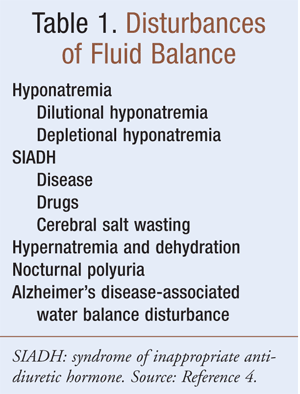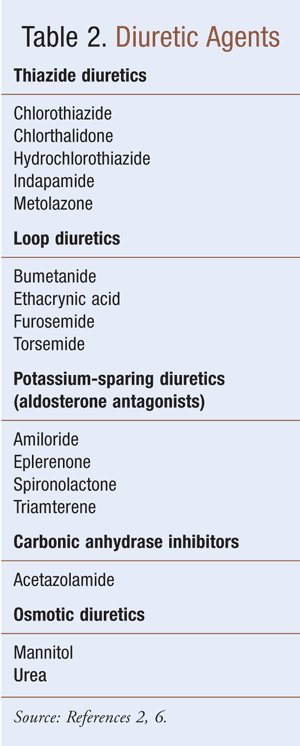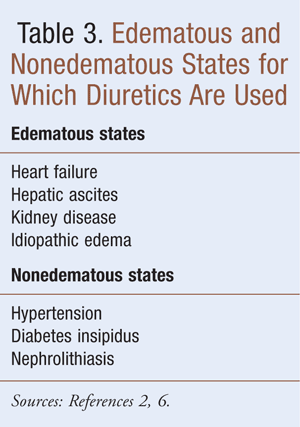Disturbances of fluid and electrolyte balance are common in the elderly (Table 1). This is not surprising since water accounts for approximately 60% of body weight in healthy young individuals, but accounts for only 45% in healthy seniors.1 In addition, regulatory systems involved in the control of fluid and electrolyte balance are affected by normal aging. For example, aging kidneys are less able to regulate the excretion of water and concentration of urine as necessary.1,2 Normal regulation of fluid and electrolyte balance requires an interplay of homeostatic systems to maintain the composition of constituents within very narrow limits, despite wide variations in dietary intake, metabolic activity, and environmental stresses.3,4

While homeostasis of body fluids is preserved primarily by the kidneys, Miller summarizes the key regulatory components of fluid balance as follows:
• Thirst perception, which governs fluid intake
• The kidneys, which are governed by hemodynamic forces
• The influence of the hormones arginine vasopressin (AVP), also known as antidiuretic hormone (ADH); atrial natriuretic hormone (ANH); and the renin-angiotensin-aldosterone system, all of which control renal water and electrolyte excretion.4
Impact of Fluid Imbalance
In addition to age-related changes, diseases and drugs can lead to disturbances of fluid balance with symptomatic consequences. Disorders, whether acute (e.g., pneumonia, traumatic brain injury) or chronic (e.g., renal failure, diabetes mellitus), and particularly those conditions that cause fever, vomiting, or diarrhea, can provoke problems with fluid and electrolyte balance.1,4 Select drug-induced changes in sodium and water regulation are discussed below.
With regard to seniors, age-related alterations in fluid and electrolyte regulatory systems result in the diminished capacity of an elderly individual to withstand challenges including physiologic stress, disease, and drugs. Ultimately, an increased risk for the development of alterations in sodium and water balance ensues, which may adversely affect functional status and mortality.4 One study looked to determine the eventual consequences (i.e., falls, unsteadiness, and cognitive impairment) of mild chronic hyponatremia, which is generally considered to be asymptomatic.5 The researchers found that mild chronic hyponatremia induces a high incidence of falls, possibly as the result of marked gait and attention impairments.5 They recommended that treating these patients might prevent a considerable number of hospitalizations.5
Pharmacists have an opportunity to explain to seniors and their caregivers that it is the balance of water and dissolved minerals (electrolytes, including sodium, potassium, and calcium) that is so important. Patients should be informed that water is the main component of blood and cells and that both too little water (dehydration) or too much water (overhydration) may cause problems to arise.
Water and Sodium Balance
There is a close interdependence between water and sodium. As previously mentioned, an individual’s total body water is about 60% of body weight—ranging from about 50% in obese people to 70% in lean people—and only 45% in healthy seniors.1,3 Total body water is made up of the intracellular compartment (two-thirds) and the extracellular compartment (one third). The major intracellular cation is potassium; the major extracellular cation is sodium, with an average concentration of 140 mEq/L. For a detailed discussion of fluid and electrolyte metabolism, including disorders of potassium and calcium, refer to Reference 3.
Intake and excretion of water: Average daily fluid intake is about 2.5 L, although periodically an average young adult with normal kidney function may ingest as little as 200 mL of water each day to excrete the nitrogenous and other wastes generated by cellular metabolism.3 A greater amount of fluid per day is needed in people with any loss of renal concentrating capacity, such as that seen in the elderly; in patients with diabetes insipidus, certain renal disorders, hypercalcemia, severe salt restriction, chronic overhydration, or hyperkalemia; in individuals ingesting ethanol, phenytoin, lithium, demeclocycline, or amphotericin B; and in people with osmotic diuresis (as caused by high-protein diets or hyperglycemia).3 Water loss also occurs from the lungs and skin as a consequence of fever, vomiting, and/or diarrhea; during heat exposure or excessive exercise, fluid loss through sweat can be significant.3
Water intake is regulated by thirst, which is triggered by receptors in the hypothalamus responding to either increased serum osmolality or decreased body-fluid volume.3 Water excretion via the kidneys is regulated primarily by AVP, resulting in increased water reabsorption in the distal nephron.3 Stimulation of AVP release by the pituitary may be secondary to an increase in serum osmolality, a decrease in blood volume, a decrease in blood pressure, or stress.3 Certain substances, including ethanol and phenytoin, or conditions, such as central diabetes insipidus, may impair AVP release.3 Serum osmolality is decreased by the intake of water. When serum osmolality is low, AVP secretion is inhibited, thus causing the kidneys to produce dilute urine.3 Daily fluid intake amounts of greater than 25 L quickly lower serum osmolality.
Elderly individuals often do not drink enough water, which can be especially problematic in hot weather. There are several reasons for this, including: 1) the tendency to be less thirsty; 2) the inability to access water due to difficulty with ambulation secondary to disease and/or disability; and 3) the purposeful avoidance of fluids so as not to exacerbate urinary incontinence.1 Data indicate that elderly patients with cerebrovascular accidents have impaired thirst perception even during states of potent stimuli for thirst, such as volume depletion and hyperosmolality.4 Even elderly Alzheimer’s patients exposed to water deprivation fail to drink in spite of the body's natural measures to raise the thirst threshold (i.e., an accompanying elevation of blood osmolality in response to water deprivation).4
Disordered water regulation in Alzheimer’s disease: There is an increased risk for disturbances in water regulation in patients with Alzheimer’s disease. These patients have an impaired thirst perception and decreased vasopressin secretion. Clinical consequences include increased risk of dehydration, hypertonicity (increased serum sodium and osmolality), reversal of day-night urine flow rate, and nocturnal polyuria and incontinence.4 As compared with age-matched subjects, persons with Alzheimer’s disease show a smaller rise in plasma vasopressin subsequent to dehydration.4 Alzheimer’s patients have a high prevalence of nocturia and nocturnal polyuria; cognitive impairment may cause nocturnal polyuria to be clinically expressed as urinary incontinence.4
Drug-Induced Changes in Fluid Regulation
Certain medications taken by seniors can affect water balance by acting on the kidneys directly or by modifying AVP release or action; the risk for syndrome of inappropriate antidiuretic hormone (SIADH) may be increased by many drugs.4
Diuretics (Table 2) induce a state of increased urine flow and are used in the treatment of both edematous and nonedematous states (Table 3). In addition to increasing urine volume, diuretics often change the pH of urine as well as the ionic component of urine and blood.4 With regard to the kidneys, most diuretics act upon a single anatomic segment of the nephron.


Thiazides are the most commonly used of the diuretic agents. Thiazides, developed from efforts to synthesize more potent carbonic anhydrase inhibitors, exert their effect by inhibiting sodium and chlorine reabsorption predominantly in the distal convoluted tubule; some agents in this category exhibit significant carbonic anhydrase inhibitory activity.6 Loop, or high-ceiling diuretics, are the most efficacious in mobilizing sodium and chlorine from the body as compared to all other classes of diuretics.2 Loop diuretics cause sodium loss.
Potassium-sparing diuretics antagonize the effects of aldosterone; inhibition may occur by direct pharmacologic antagonism of mineralocorticoid receptors (spironolactone, eplerenone) or by inhibition of sodium influx through ion channels in the luminal membrane (amiloride, triamterene).2,6 Potassium-sparing diuretics reduce sodium absorption in the collecting tubules and ducts; sodium absorption (and potassium secretion) at these sites is regulated by aldosterone.6 Acetazolamide, a carbonic anhydrase inhibitor, is a weak diuretic and much less effective than thiazides and loop diuretics; it is more often used for other pharmacologic actions (e.g., in acute mountain sickness, glaucoma), rather than for diuretic effect.
Osmotic diuretics act by carrying water with them into the renal tubular fluid. They are used to effect increased water excretion rather than increased sodium excretion.2 These agents are used to maintain urine flow following acute toxic ingestion of substances capable of causing renal failure; maintaining urine flow helps to preserve renal function and may avoid the need for dialysis.2
Hyponatremia caused by loop diuretics can be a combined depletional and dilutional hyponatremia. Occurring almost entirely in the elderly, thiazide diuretic–associated hyponatremia induces sodium loss and is frequently accompanied by loss of total body potassium; activation of hypothalamic pathways may ensue, leading to an AVP discharge surge, water retention, and SIADH.4 Correction of potassium depletion is required to reverse the condition.
Psychotropic agents: First-generation antipsychotic agents (e.g., fluphenazine, thiothixene), tricyclic amtidepressants (TCAs), selective serotonin reuptake inhibitors (SSRIs), and serotonin-norepinephrine reuptake inhibitors (SNRIs), have been associated with hyponatremia with characteristics of SIADH.
Further, induction of SIADH by SSRIs has also been reported.4 While the most commonly reported SSRI to cause hyponatremia is fluoxetine, others, including paroxetine, sertraline, fluvoxamine, citalopram, and escitalopram have been involved as well.4 Patients over the age of 65 years are at greatest risk for SSRI-induced hyponatremia; in this group, onset of hyponatremia typically occurs within 2 weeks after drug initiation.4 SNRIs such as venlafaxine and duloxetine are also capable of causing SIADH-type hyponatremia, according to recent evidence.4
ACE inhibitors can produce hyponatremia that appears to be dilutional with features of SIADH; resolution occurs upon discontinuation of the drug.4 Other agents that have been associated with hyponatremia include the antihyperglycemic agent chlorpropamide, the anticonvulsant agent carbamazepine, and the antineoplastic agents vincristine, vinblastine, and cyclophosphamide.4 In postoperative patients, analgesics, including and especially narcotics, may be the cause of hyponatremia.4 Nonsteroidal anti-inflammatory agents cause sodium retention.
Summary
Abnormalities in fluid volume and electrolyte composition are common in seniors and considered important clinical problems. Normal regulation of water and electrolyte balance requires homeostatic systems that may be compromised as a result of alterations associated with normal aging. In addition to age-related changes, disease and drugs may also cause disturbances in fluid and electrolyte balance. Pharmacists are encouraged to monitor for water and sodium disturbances, especially in seniors who are challenged by illness, pharmacologic agents, or external factors involving fluid access and dietary constituents.
REFERENCES
1. Beers MH, Jones TV, Berkwits M, et al, eds. The Merck Manual of Health & Aging. Whitehouse Station, NJ: Merck Research Laboratories; 2004:213-222.
2. Howland RD, Mycek MJ. Pharmacology. 3rd ed. Philadelphia, PA: Lippincott Williams & Wilkins; 2006:261-274.
3. Fluid and electrolyte metabolism. The Merck Manual. Full revision May 2009.
www.merckmanuals.com/
4. Miller M. Disorders of fluid balance. In: Halter JB, Ouslander JG, Tinetti ME, et al, eds. Hazzard’s Geriatric Medicine and Gerontology. 6th ed. New York, NY: McGraw-Hill; 2009:1047-1058.
5. Renneboog B, Musch W, Vandemergel X, et al. Mild chronic hyponatremia is associated with falls, unsteadiness, and attention deficits. Am J Med. 2006;119(1):71.e1-8.
6. Ives HE. Diuretic agents. In: Katzung BG. Basic and Clinical Pharmacology. 9th ed. New York, NY:McGraw-Hill; 2004:241-258.





